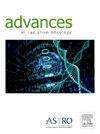Key Insights and Implementation of a Patient-Centered Education Video For Managing Acute Radiation Dermatitis in Breast Cancer: A Single-Center Pilot Study
IF 2.2
Q3 ONCOLOGY
引用次数: 0
Abstract
Purpose
This study aimed to develop an educational tool to improve breast cancer patients' understanding of radiation therapy (RT) and analyze its usage.
Methods and Materials
A single-arm trial was conducted at a tertiary hospital in Taiwan with newly diagnosed breast cancer patients scheduled for RT. Patients viewed a 4-minute educational video explaining RT mechanisms, self-care for irradiated skin, treatment precautions, and radiation dermatitis toxicity grading. A QR code provided video access. The Skindex-16 (traditional Chinese version) questionnaire assessed skin reactions before, during, and after RT. A satisfaction survey was also administered post-RT.
Results
Of the 57 enrolled patients, 51 completed the study. Most found the video satisfactory (90.2%) and easy to understand (86.3%). The video provided emotional support (90.2%) and reduced anxiety (84.3%). Nearly all patients (96.1%) found the QR code helpful. Skindex-16 outcomes indicated increasing discomfort throughout treatment, with a significant rise midway through RT. Patient characteristics, such as age, education, occupation, and social support, were not correlated with satisfaction, emotional support efficacy, or video-watching frequency. Subgroup analysis showed no significant differences in Skindex-16 scores between conventional and hypofractionated RT. Most patients (82.4%) watched the video most frequently during the first 2 weeks of RT, with 25.5% replaying it when dermatitis worsened.
Conclusions
The in-house educational video enhanced patients' understanding of RT and provided emotional support, with efficacy unaffected by patient characteristics or fractionation. Patients valued QR code access. The timing of watching the video was crucial. Continuous, accessible educational materials were important as symptoms worsened at the first follow-up. This study paved the way for future clinical trials and educational tools for breast cancer patients in radiation oncology departments.
以患者为中心的教育视频对乳腺癌急性放射性皮炎管理的关键见解和实施:一项单中心试点研究
目的开发一种教育工具,提高乳腺癌患者对放射治疗的认识,并分析其使用情况。方法与材料在台湾某三级医院对新诊断的乳腺癌患者进行了单臂试验。患者观看了一段4分钟的教育视频,讲解了放疗机制、照射后皮肤的自我护理、治疗注意事项以及放射性皮炎毒性分级。QR码提供视频访问。皮肤指数-16(传统中文版)问卷评估皮肤反应之前,期间和之后的rt。满意度调查也进行了rt后。结果在57例入组患者中,51例完成了研究。大多数人认为视频令人满意(90.2%),易于理解(86.3%)。该视频提供了情感支持(90.2%),减少了焦虑(84.3%)。几乎所有患者(96.1%)都认为二维码有帮助。skin index-16的结果显示,在整个治疗过程中,不适感增加,在治疗的中途显著增加。患者的特征,如年龄、教育程度、职业和社会支持,与满意度、情感支持有效性或视频观看频率无关。亚组分析显示,常规和减分放疗的Skindex-16评分无显著差异。大多数患者(82.4%)在放疗的前2周最频繁地观看该视频,25.5%的患者在皮炎恶化时重播该视频。结论内部教育视频提高了患者对放疗的认识,并提供了情感支持,其效果不受患者特征或分科的影响。患者重视QR码访问。观看视频的时机至关重要。由于症状在第一次随访时恶化,持续的、可获得的教育材料非常重要。这项研究为未来的临床试验和放疗肿瘤科乳腺癌患者的教育工具铺平了道路。
本文章由计算机程序翻译,如有差异,请以英文原文为准。
求助全文
约1分钟内获得全文
求助全文
来源期刊

Advances in Radiation Oncology
Medicine-Radiology, Nuclear Medicine and Imaging
CiteScore
4.60
自引率
4.30%
发文量
208
审稿时长
98 days
期刊介绍:
The purpose of Advances is to provide information for clinicians who use radiation therapy by publishing: Clinical trial reports and reanalyses. Basic science original reports. Manuscripts examining health services research, comparative and cost effectiveness research, and systematic reviews. Case reports documenting unusual problems and solutions. High quality multi and single institutional series, as well as other novel retrospective hypothesis generating series. Timely critical reviews on important topics in radiation oncology, such as side effects. Articles reporting the natural history of disease and patterns of failure, particularly as they relate to treatment volume delineation. Articles on safety and quality in radiation therapy. Essays on clinical experience. Articles on practice transformation in radiation oncology, in particular: Aspects of health policy that may impact the future practice of radiation oncology. How information technology, such as data analytics and systems innovations, will change radiation oncology practice. Articles on imaging as they relate to radiation therapy treatment.
 求助内容:
求助内容: 应助结果提醒方式:
应助结果提醒方式:


